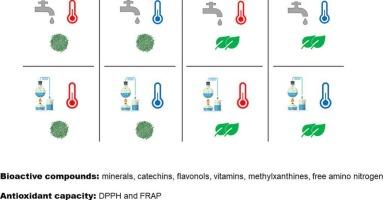优化低温绿茶冲泡的冲泡条件:对功能和营养特性的见解
IF 9.8
1区 农林科学
Q1 CHEMISTRY, APPLIED
引用次数: 0
摘要
为了应对功能性、低加工食品需求的增长和能源成本的上升,研究人员探索了多种低温绿茶酿造条件,以替代高温加工。在85 °C条件下,用蒸馏水和细磨的茶叶(<; 500μm)。虽然自来水也建议使用类似的条件,但根据分光光度法和色谱分析,这导致儿茶素产量和抗氧化能力(AC)大幅下降。将提取温度降低到20 °C,用蒸馏水酿造12 小时,与任何高温酿造方法相比,可以获得异常高的AC,以及维生素C,维生素B2,表儿茶素和表没食子儿茶素的产量。值得注意的是,只有在使用整片茶叶而不是茶粉时才观察到这些益处。需要进一步的研究来解决蒸馏水工业绿茶生产的技术挑战。本文章由计算机程序翻译,如有差异,请以英文原文为准。

Optimizing brewing conditions for low-temperature green tea infusions: Insights into functional and nutritional properties
In response to growing demand for functional, minimally processed foods and rising energy costs, various brewing conditions for low-temperature green tea production were explored as an alternative to high-temperature processing. Optimal catechin extraction was achieved at 85 °C for 30 min using distilled water and finely ground leaves (< 500 μm). Although similar conditions are recommended for tap water, this resulted in a tremendous reduction in both catechin yields and antioxidant capacity (AC), as determined by spectrophotometric and chromatographic analyses. Lowering extraction temperature to 20 °C and brewing for 12 h with distilled water led to exceptionally high AC, along with increased yields of vitamin C, vitamin B2, epicatechin, and epigallocatechin, compared to any high-temperature brewing method. Notably, these benefits were only observed when whole leaves were used, rather than tea powder. Further research is needed to address technological challenges for industrial green tea production with distilled water.
求助全文
通过发布文献求助,成功后即可免费获取论文全文。
去求助
来源期刊

Food Chemistry
工程技术-食品科技
CiteScore
16.30
自引率
10.20%
发文量
3130
审稿时长
122 days
期刊介绍:
Food Chemistry publishes original research papers dealing with the advancement of the chemistry and biochemistry of foods or the analytical methods/ approach used. All papers should focus on the novelty of the research carried out.
 求助内容:
求助内容: 应助结果提醒方式:
应助结果提醒方式:


